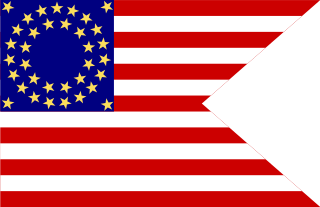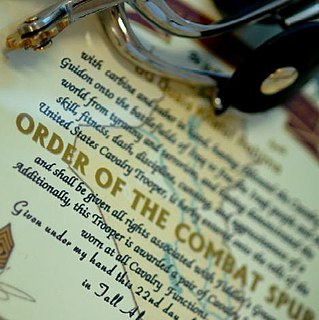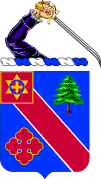Related Research Articles

The flag of the United States Marine Corps is the flag used to represent the U.S. Marine Corps, as well as its subsidiary units and formations.

The 38th Infantry Division ("Cyclone") is one of the eighteen divisions of the United States Army, and one of eight National Guard divisions. It is headquartered in Indianapolis, Indiana, and contains Army National Guard units from Indiana, Ohio, Kentucky, Delaware, Michigan, Tennessee and Other States.

In the United States Army, Navy, Marine Corps, Coast Guard and Air Force, a guidon is a military standard that company/battery/troop or platoon-sized detachments carry to signify their unit designation and branch/corps affiliation or the title of the individual who carries it. A basic guidon can be rectangular, but sometimes has a triangular portion removed from the fly.

A shoulder sleeve insignia, is an embroidered patch worn on some uniforms of the United States Army. It is used by major formations of the U.S. Army; each formation has a unique formation patch. The U.S. Army is unique among the U.S. Armed Forces in that all soldiers are required to wear the patch of their headquarters as part of their military uniforms.

Semper Paratus is a Latin phrase, meaning "Always Ready". Sometimes shortened to Semper Par. It is used as the official motto of some organizations, such as the United States Coast Guard. A 1928 song of the same name is also used as the U.S. Coast Guard's official march, and appears on the organization's flag.

The Order of the Spur is a Cavalry tradition within the United States Army. Soldiers serving with Cavalry units are inducted into the Order of the Spur after successfully completing a "Spur Ride" or for having served during combat as a member of or with a Cavalry unit. A trooper who has earned both Silver and Gold spurs is known as a "Master Spur Holder." Traditionally, each Trooper is presented spurs by his sponsor at a ceremonial dining in commonly referred to as the "Spur Dinner". The spurs are to be worn with the military uniform during Squadron or Regimental ceremonies and events or as designated by the Cavalry unit commander. In some units, gold spurs are awarded for combat inductions while silver spurs represent having completed the Spur Ride. Within the tradition, silver spurs and gold spurs hold a similar relationship for the cavalry as the Expert Infantryman Badge hold in the U.S. Army Infantry, as well as the Expert Field Medical Badge and the Combat Medical Badge hold to U.S. Army Medics. There is no Military Occupational Specialty (MOS) requirement for the Order of the Spur and the order is open to members of foreign militaries serving with U.S. Cavalry units.
The 5th Maryland Regiment is a designation which has been held by several units over the years, not all of which necessarily share the same lineage and honors. Although the first unit to carry the "5th Maryland" designation was organized in 1776 from volunteers in rural Maryland, the designation has been most often associated with militia units in Baltimore. The "5th Maryland" designation is the officially recognized traditional designation of the 175th Infantry Regiment, Maryland Army National Guard. This entry refers to the rural 5th Maryland, whose lineage is separate and distinct from the Baltimore 5th Maryland perpetuated by the 175th Infantry Regiment.

The Texas Army National Guard is a component of the United States Army, the United States National Guard and the Texas Military Forces.

The Maryland Army National Guard is the United States Army component of the American state of Maryland. It is headquartered at the old Fifth Regiment Armory at the intersection of North Howard Street, 29th Division Street, near Martin Luther King, Jr. Boulevard in Baltimore and has additional units assigned and quartered at several regional armories, bases/camps and other facilities across the state.

In the United States (US) armed forces, a beret flash is a shield-shaped embroidered cloth or metallic insignia that is usually attached to a stiffener backing of a military beret. Today, the attached flash is worn over the left eye of the wearer with the excess cloth of the beret folded and pulled over the right ear giving it a distinctive shape. The embroidered designs of the US Army's organizational beret flashes represent the distinctive heraldic colors and patterns of the unit or organization to which they are assigned while the US Air Force's represent their Air Force specialty code (AFSC) or their assignment to a special unit. Joint beret flashes, such as the Multinational Force and Observers and United Nations Peacekeepers beret flashes, are worn by all of the US armed forces on unique berets while assigned to a specific multinational mission.

The structure of the United States Army is complex, and can be interpreted in several different ways: active/reserve, operational/administrative, and branches/functional areas.

The 158th Infantry Regiment ("Bushmasters") is an infantry unit of the Arizona National Guard. The regiment has served abroad in World War I, World War II and Afghanistan.

In the United States Army, "tabs" are small cloth and/or metal arches displaying a word or words signifying a special skill that are worn on U.S. Army uniforms. On the Army Combat Uniform, the tabs are worn above a unit's shoulder patch and are used to identify a unit's or a soldier's special skill(s) or are worn on shoulder patches as part of a unit's unique heritage. Individual tabs are also worn as small metal arches above or below medals or ribbons on the Army Service Uniform.

The 116th Cavalry Brigade Combat Team is the largest formation of the Idaho Army National Guard. It is headquartered at Gowen Field, Boise, Idaho. It has been reorganized into an Armored Brigade Combat Team (ABCT) but remains the only unit to be designated a "Cavalry Brigade Combat Team" by special appointment of the US Army. The 116th Cavalry Brigade Combat Team has units located throughout Idaho, Montana, Oregon, and Nevada. It was reorganized into a heavy armor brigade in 1989. Often referred to as the Snake River Brigade and formerly known as the 116th Armored Cavalry Regiment, the unit includes about 3,000 citizen-soldiers from Idaho.

The 211th Military Police Battalion is a unit of the Massachusetts Army National Guard. Its Headquarters and Headquarters Detachment is descended from the First Corps of Cadets, initially formed in 1741. It is one of several National Guard units with colonial roots. Its motto is Monstrat Viam – "It Points the Way." While it has served in five wars, the sub-unit's primary contribution to Massachusetts and to the United States was as an officer-producing institution for new regiments from the Revolutionary War through World War II.

The 3rd Battalion, 172nd Infantry Regiment (Mountain), also known as the "Mountain Battalion", is a Vermont Army National Guard light infantry battalion which specializes in mountainous and cold weather operations. The unit falls under the command of the Vermont Army National Guard's 86th Infantry Brigade Combat Team (Mountain).
The lineage and honors certificate is a legal document, which contains certain words and phrases, that have a specific meaning. it is the official "birth, graduation, wedding, and death certificate" of a unit. As a U.S. Government generated document it cannot be copyrighted and is in the public domain. It is also used to keep track of a units awards, and battle honors. It is not a "unit history/combat chronicle", although many historians have used them for outlines. Note that when two units are consolidated both units bring their honors with them. This can confuse the layman in that a unit that served in Europe can have South Seas honors from another unit with which it combined.
The 131st Cavalry Regiment was a regiment of the Alabama National Guard. It was authorized the special designation "Southern Leaders" and its motto was "Taught to Lead".
References
